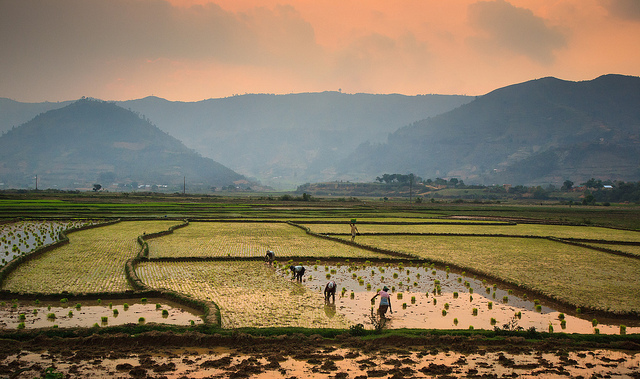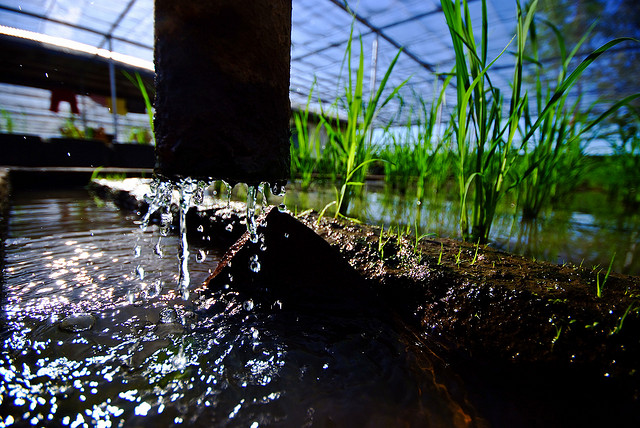It is important to keep good water management when it comes to the planting and maintenance of rice plants to keep a good quality and healthy crop harvest. Rice paddy fields are the most water consuming cultivation crop of which up to a fifth of the overall world’s population depends on rice as a way of life. From this you can simply see that a huge quantity of water is and has been consumed through the cultivation of rice. Even now rice cultivation still increases to consume vast quantities of water although methods have been used to lower the consumption of water. This can hold a problem for many rice farms annually and why the importance of water management can be a crucial factor to the overall cultivation of rice. In fact every year many rice paddy fields fall victim to scarce water supplies. It is known that around 2025 as many as 20 million rice farms will suffer from lack of water supplies!
Depending whether you are a rice paddy field farmer or deep water rice farmer the quantity of irrigated water will vary but the basis of water management methods are the same. Deep water rice cultivation requires much rainfall so when there are periods with little or no rainfall irrigated water is a must to ensure the survival of the crop. Rice paddy fields are more reliant on irrigated water methods throughout cultivation unless periods of rainfall occur. You will always need good water management whether you are a deep water rice farmer or rice paddy field farmer to ensure the survival and harvest of the crop!
Before getting into the methods it is first important to know about the water flow in terms of inflow and outflow. There are a few water processes that take place which are transpiration, evaporation, seepage and percolation. You can find more about the flow of water here: Inflow and Outflow of Water
It is also important to understand the effectiveness of water in relation to the growth of rice plants. Rice plants are not a fully aquatic plant which means they do not require to be submerged in water, and in fact a large misconception is that they require growing in water! Rice does not actually require to be grown in these conditions however there is reasoning: Why Grow Rice in Water?

Methods of Water Management
Land Structure
Implementing methods for water management starts near the initial processes of rice cultivation. Land preparation is set out to design the overall cultivating area hence it is vital to consider how water flow and its use will affect the crop as well as how you will sustain water in the area. Rice paddy fields will typically have mud built walls called bunds, these walls are low barriers to stop the flow of water escaping the boundaries of your cultivating area. Apart from the bund walls a draining feature will be required in case of high rainfall and unwanted increase in water levels. The drainage system is highly efficient if it takes into consideration the reuse ability of water to increase water levels when required. However you could quite simply implement a gate sort of feature to the bund walls for water to pass through when needed.
A significant part of land preparation is levelling the ground which can have a big impact on the quantity of water consumed, more specifically in larger farming areas. With uneven ground specific areas will require more water to raise levels to the required size. It can also lead to mixed crop yield due to the extra attention water management over the land would require. Harrowing is a land preparation technique that will affect the levelling of the ground which can easily be utilized to level the ground.
Reducing Percolation Rates – Puddling
Percolation is simply the flow of water downwards into the soil. Filtration is the reasoning for rates of percolation, think of the soil as a filter for the water. With all the debris, materials and matter within the soil will create more obstacles in the filter that water flowing through has to overcome. Different areas will have different percolation rates that can affect water consumption.
A method for slowing percolation rates which is popular with rice cultivation is known as puddling. Puddling is mixing water with the soil which decrease soil pores. Soil pores are pathways in the soil that in essence help the flow of water pass through the soil. So why would this be good water management for rice production? By implementing puddling the soil is going to have slower percolation rates and therefore less water will be lost down into the soil and overall saving water. Not only does puddling help with water management but helps with the production due to nutrients being more available and roots of the plants being able to penetrate the soil more effectively due to lessened soil strength.

Reusing Water
A great water management system employs the method of reusing water in that the rice plants have not utilized as well as any excess water and any captured outflow. By making use of reused water you are reducing water loss significantly and helping to minimize the water consumption of rice cultivation. With drainage systems you can easily capture water, however with the reuse of water there also comes disadvantages. When you have managed to capture and store the water you will also need to filter out its contents as harmful contaminants may enter the water and if you do not filter them you will just be adding them to the crops water supply when you initially would have just thrown the water away.
Setting up a water management system that takes the recycling of water into account is effective but does result in increased effort but, decreases water costs and can prevent the outcome of running out of water. Essentially you can increase the survival rate of the crop.
AWD – Alternate Wetting and Drying
AWD is a method introduced to rice farmers, more specifically rice paddy field farmers as opposed to deep water rice farmers. The method was designed to decrease water consumption of rice cultivation up to 25%! This will help many rice farmers maintain higher water levels available to them to continue rice cultivation, reducing the risks of running out of water vital to the success of a good quality crop yield.
Simply it deals with measuring water levels in the field to maintain low but still sufficient water available for access from the roots of rice plants. The name Wetting and Drying is in relation to the method as it wets the field (adding irrigated water) and then holds off topping up water levels until they are around a length of 15cm underground which in effect dries the top of the soil.
In the process of rice cultivation the rice plants do not require to be standing in water. As long as the roots of the plant have sufficient access to water the crops will still produce good quality in relation to water management. This also leads to good soil aeration which benefits the crop by allowing access to beneficial gasses in the air.

